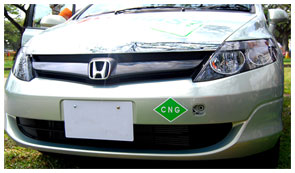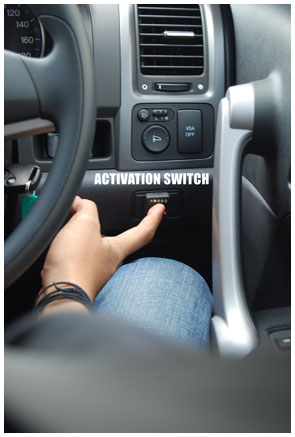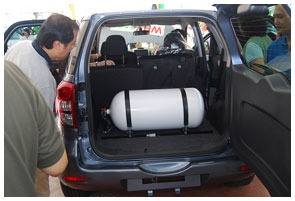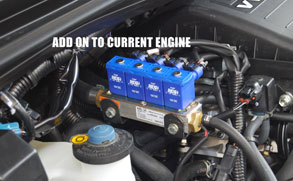Alternative Fuel - ChaNGe Fuels, Save the World!
23 Jan 2008|62,241 views
 Environmentally friendly vehicles are quite the rage nowadays. Everyone, from superstars to the regular dude on the street, is talking about it. Bio-diesel, Hybrid, CNG, Solar, electric cars all seem like the "it" words for the moment. Spearheaded by celebrities like Brad Pitt, Cameron Diaz, Ellen Degeneres and Will Ferrell, there has been no better time to talk about environmentally friendly cars than right now. I mean, if celebrities are doing their part, shouldn't you? Now, if only they would stop jetting about in their private jets, I would be the first to commend them on being really environmentally conscious.
Environmentally friendly vehicles are quite the rage nowadays. Everyone, from superstars to the regular dude on the street, is talking about it. Bio-diesel, Hybrid, CNG, Solar, electric cars all seem like the "it" words for the moment. Spearheaded by celebrities like Brad Pitt, Cameron Diaz, Ellen Degeneres and Will Ferrell, there has been no better time to talk about environmentally friendly cars than right now. I mean, if celebrities are doing their part, shouldn't you? Now, if only they would stop jetting about in their private jets, I would be the first to commend them on being really environmentally conscious. The current buzz in Singapore right now is CNG or Compressed Natural Gas. Taxi companies are taking the lead by installing their new fleets with a CNG system. But talk about alternative fuel to the typical boyracer wannabe and he will snap back, "GOT POWER SI BO????" Speak to the typical heartlander and you get, "These new kind of cars all expensive lor!!!! Where got worth it??" Speak to the rather informed crowd and you have this for a reply, "Only one filling station in Singapore. How is that gonna make me buy a car fitted with the CNG system?"
The concerns by these folks reflect the views of motorists in Singapore today with regards to green cars. While many would want to take the leap to do their part for the environment, they are unable to do so for they cannot make an informed decision. It does not help that the early hybrid and other green cars were sold at a considerably higher price. In Singapore, buying a car is quite a big financial deal, so people are really apprehensive about buying a car they are not familiar with.
So what is CNG?
Natural Gas is a fossil fuel that is more evenly distributed than crude oil worldwide. Compressed Natural Gas is natural gas that is stored in cylinders with pressures of up to 3600 pounds per square inch. CNG made up mostly of Methane, is lighter than air, odorless and colourless. When released into the air, it disperses quickly and will not form a rich enough mixture for combustion. In a nutshell, it will not burn easily and it is thus safer in the event of a leak.
Contrary to popular belief, CNG has a high octane level. 130, to be exact. Even Shell's V-power does not have that much. So, theoretically, CNG should give more bang for your buck. A higher octane level also allows for higher compression ratios and improved thermal efficiency. This means lesser carbon dioxide emission into our already ailing atmosphere. CNG is also beneficial in so many other ways. 40% less Nitrous Oxide, 90% less hydrocarbons, 80% less carbon monoxide, 25% less carbon dioxide, all make for a healthier place to live in. For your information, hydrocarbons carry carcinogens, which are substances that will lead to, cancer.
 Surely, you would ask, if something were really this good, it would have been used decades ago. Well, you are right. The idea of natural gas as an automotive fuel goes as far back as the 1930s. The Australians considered it an automotive fuel in 1937 and the French used it in WW1. Since then, there has been little growth in the use of natural gas, until recent times. Currently, our little island needs to quicken the pace and catch up with other countries around the world. The United States have got more than 1300 refueling stations in almost every state. Some Americans have got home refueling systems even. Compare that to our ONE refueling station and you can see what I mean when I say we are quite behind time. For a country that is always striving to the best and being a hub for everything from R&D to sports, it is quite baffling why we are not pushing the need for a betterment of our planet pertaining to vehicular emissions. Fair enough, by the end of this month, there will another one in Mandai and after that another one at Jalan Buroh. But yes, 3 stations compared to 1300 is quite a difference, to put it kindly.
Surely, you would ask, if something were really this good, it would have been used decades ago. Well, you are right. The idea of natural gas as an automotive fuel goes as far back as the 1930s. The Australians considered it an automotive fuel in 1937 and the French used it in WW1. Since then, there has been little growth in the use of natural gas, until recent times. Currently, our little island needs to quicken the pace and catch up with other countries around the world. The United States have got more than 1300 refueling stations in almost every state. Some Americans have got home refueling systems even. Compare that to our ONE refueling station and you can see what I mean when I say we are quite behind time. For a country that is always striving to the best and being a hub for everything from R&D to sports, it is quite baffling why we are not pushing the need for a betterment of our planet pertaining to vehicular emissions. Fair enough, by the end of this month, there will another one in Mandai and after that another one at Jalan Buroh. But yes, 3 stations compared to 1300 is quite a difference, to put it kindly. Then again, 3 stations would be enough for now as the CNG system works as a compliment to the current petrol system. The car is not a dedicated CNG vehicle; you can choose to use CNG or petrol or both, all at the press of a button. The system allows you to fully run on petrol should you run out of gas. Thus, it is guaranteed that you will not be caught in a situation where you will have to push your car all the way to Jurong Island or Mandai. The system also comes with a gauge for the amount of gas left in the tank. A visit to Mandai once in a while is not so bad is it?
The loss of power is very minimal. On the Honda CRV the difference in power is probably about 5 to 10%. Acceleration from standstill was decent though the car was more aggressive on petrol. But with the amount of money saved, the minimal power loss is a small price to pay and which many would be able to live with.
 So let us recap. The CNG system helps us to bring the cost of fuel down, it is less dangerous than petrol and the power loss suffered is minimal. What are you waiting for? Even with a cost of $3800 for installation of a CNG system, the savings you make will cover that initial investment and you will continue to save even more as you use the system for a longer period of time.
So let us recap. The CNG system helps us to bring the cost of fuel down, it is less dangerous than petrol and the power loss suffered is minimal. What are you waiting for? Even with a cost of $3800 for installation of a CNG system, the savings you make will cover that initial investment and you will continue to save even more as you use the system for a longer period of time. But before you speed off to the nearest car dealer to switch to a brand new CNG vehicle, there are some drawbacks to the whole system. The one that sticks out most (literally) would be the tank. On a Toyota Rush, the tank fills up about 70% of the entire boot. You are only left with space to put several shoes, umbrellas and maybe boxes of A4 paper. Anything bigger would be a challenge similar to a Rubick's cube. The tank is also relatively heavy. It weighs about 66kg. So at any one point, it is like traveling with an extra passenger. The added weight means a lower power to weight ratio and an increase in fuel consumption but you still save when you use CNG by virtue of its price alone!
 |  |
Some visitors to the fair organized by Pinnacle have also commented that having that tank seems dangerous. Even if the gas is almost non-combustible, it is still compressed. Should it be punctured, the tank could fly off like a Scud missile on a mission. But in my opinion, it will take quite an effort to puncture that tank for it feels and look very hardy. But still, this is the reason why LTA takes a serious view on how the installation is done. All new CNG vehicles will have to go for an inspection on the worthiness of the installation. Those that fail to comply with the guidelines will not qualify to go on the road.
So it really is up to you folks. While CNG in Singapore is still new, there is a bright future ahead for it. Soon, the tanks will get smaller and lighter and the number of refueling stations will increase. When that happens, let us all do our part in saving the environment.
Saving the cheerleader will not save the Earth. Changing fuels might. For the love of our mother earth. Peace.
 Environmentally friendly vehicles are quite the rage nowadays. Everyone, from superstars to the regular dude on the street, is talking about it. Bio-diesel, Hybrid, CNG, Solar, electric cars all seem like the "it" words for the moment. Spearheaded by celebrities like Brad Pitt, Cameron Diaz, Ellen Degeneres and Will Ferrell, there has been no better time to talk about environmentally friendly cars than right now. I mean, if celebrities are doing their part, shouldn't you? Now, if only they would stop jetting about in their private jets, I would be the first to commend them on being really environmentally conscious.
Environmentally friendly vehicles are quite the rage nowadays. Everyone, from superstars to the regular dude on the street, is talking about it. Bio-diesel, Hybrid, CNG, Solar, electric cars all seem like the "it" words for the moment. Spearheaded by celebrities like Brad Pitt, Cameron Diaz, Ellen Degeneres and Will Ferrell, there has been no better time to talk about environmentally friendly cars than right now. I mean, if celebrities are doing their part, shouldn't you? Now, if only they would stop jetting about in their private jets, I would be the first to commend them on being really environmentally conscious. The current buzz in Singapore right now is CNG or Compressed Natural Gas. Taxi companies are taking the lead by installing their new fleets with a CNG system. But talk about alternative fuel to the typical boyracer wannabe and he will snap back, "GOT POWER SI BO????" Speak to the typical heartlander and you get, "These new kind of cars all expensive lor!!!! Where got worth it??" Speak to the rather informed crowd and you have this for a reply, "Only one filling station in Singapore. How is that gonna make me buy a car fitted with the CNG system?"
The concerns by these folks reflect the views of motorists in Singapore today with regards to green cars. While many would want to take the leap to do their part for the environment, they are unable to do so for they cannot make an informed decision. It does not help that the early hybrid and other green cars were sold at a considerably higher price. In Singapore, buying a car is quite a big financial deal, so people are really apprehensive about buying a car they are not familiar with.
So what is CNG?
Natural Gas is a fossil fuel that is more evenly distributed than crude oil worldwide. Compressed Natural Gas is natural gas that is stored in cylinders with pressures of up to 3600 pounds per square inch. CNG made up mostly of Methane, is lighter than air, odorless and colourless. When released into the air, it disperses quickly and will not form a rich enough mixture for combustion. In a nutshell, it will not burn easily and it is thus safer in the event of a leak.
Contrary to popular belief, CNG has a high octane level. 130, to be exact. Even Shell's V-power does not have that much. So, theoretically, CNG should give more bang for your buck. A higher octane level also allows for higher compression ratios and improved thermal efficiency. This means lesser carbon dioxide emission into our already ailing atmosphere. CNG is also beneficial in so many other ways. 40% less Nitrous Oxide, 90% less hydrocarbons, 80% less carbon monoxide, 25% less carbon dioxide, all make for a healthier place to live in. For your information, hydrocarbons carry carcinogens, which are substances that will lead to, cancer.
 Surely, you would ask, if something were really this good, it would have been used decades ago. Well, you are right. The idea of natural gas as an automotive fuel goes as far back as the 1930s. The Australians considered it an automotive fuel in 1937 and the French used it in WW1. Since then, there has been little growth in the use of natural gas, until recent times. Currently, our little island needs to quicken the pace and catch up with other countries around the world. The United States have got more than 1300 refueling stations in almost every state. Some Americans have got home refueling systems even. Compare that to our ONE refueling station and you can see what I mean when I say we are quite behind time. For a country that is always striving to the best and being a hub for everything from R&D to sports, it is quite baffling why we are not pushing the need for a betterment of our planet pertaining to vehicular emissions. Fair enough, by the end of this month, there will another one in Mandai and after that another one at Jalan Buroh. But yes, 3 stations compared to 1300 is quite a difference, to put it kindly.
Surely, you would ask, if something were really this good, it would have been used decades ago. Well, you are right. The idea of natural gas as an automotive fuel goes as far back as the 1930s. The Australians considered it an automotive fuel in 1937 and the French used it in WW1. Since then, there has been little growth in the use of natural gas, until recent times. Currently, our little island needs to quicken the pace and catch up with other countries around the world. The United States have got more than 1300 refueling stations in almost every state. Some Americans have got home refueling systems even. Compare that to our ONE refueling station and you can see what I mean when I say we are quite behind time. For a country that is always striving to the best and being a hub for everything from R&D to sports, it is quite baffling why we are not pushing the need for a betterment of our planet pertaining to vehicular emissions. Fair enough, by the end of this month, there will another one in Mandai and after that another one at Jalan Buroh. But yes, 3 stations compared to 1300 is quite a difference, to put it kindly. Then again, 3 stations would be enough for now as the CNG system works as a compliment to the current petrol system. The car is not a dedicated CNG vehicle; you can choose to use CNG or petrol or both, all at the press of a button. The system allows you to fully run on petrol should you run out of gas. Thus, it is guaranteed that you will not be caught in a situation where you will have to push your car all the way to Jurong Island or Mandai. The system also comes with a gauge for the amount of gas left in the tank. A visit to Mandai once in a while is not so bad is it?
The loss of power is very minimal. On the Honda CRV the difference in power is probably about 5 to 10%. Acceleration from standstill was decent though the car was more aggressive on petrol. But with the amount of money saved, the minimal power loss is a small price to pay and which many would be able to live with.
 So let us recap. The CNG system helps us to bring the cost of fuel down, it is less dangerous than petrol and the power loss suffered is minimal. What are you waiting for? Even with a cost of $3800 for installation of a CNG system, the savings you make will cover that initial investment and you will continue to save even more as you use the system for a longer period of time.
So let us recap. The CNG system helps us to bring the cost of fuel down, it is less dangerous than petrol and the power loss suffered is minimal. What are you waiting for? Even with a cost of $3800 for installation of a CNG system, the savings you make will cover that initial investment and you will continue to save even more as you use the system for a longer period of time. But before you speed off to the nearest car dealer to switch to a brand new CNG vehicle, there are some drawbacks to the whole system. The one that sticks out most (literally) would be the tank. On a Toyota Rush, the tank fills up about 70% of the entire boot. You are only left with space to put several shoes, umbrellas and maybe boxes of A4 paper. Anything bigger would be a challenge similar to a Rubick's cube. The tank is also relatively heavy. It weighs about 66kg. So at any one point, it is like traveling with an extra passenger. The added weight means a lower power to weight ratio and an increase in fuel consumption but you still save when you use CNG by virtue of its price alone!
 |  |
Some visitors to the fair organized by Pinnacle have also commented that having that tank seems dangerous. Even if the gas is almost non-combustible, it is still compressed. Should it be punctured, the tank could fly off like a Scud missile on a mission. But in my opinion, it will take quite an effort to puncture that tank for it feels and look very hardy. But still, this is the reason why LTA takes a serious view on how the installation is done. All new CNG vehicles will have to go for an inspection on the worthiness of the installation. Those that fail to comply with the guidelines will not qualify to go on the road.
So it really is up to you folks. While CNG in Singapore is still new, there is a bright future ahead for it. Soon, the tanks will get smaller and lighter and the number of refueling stations will increase. When that happens, let us all do our part in saving the environment.
Saving the cheerleader will not save the Earth. Changing fuels might. For the love of our mother earth. Peace.









